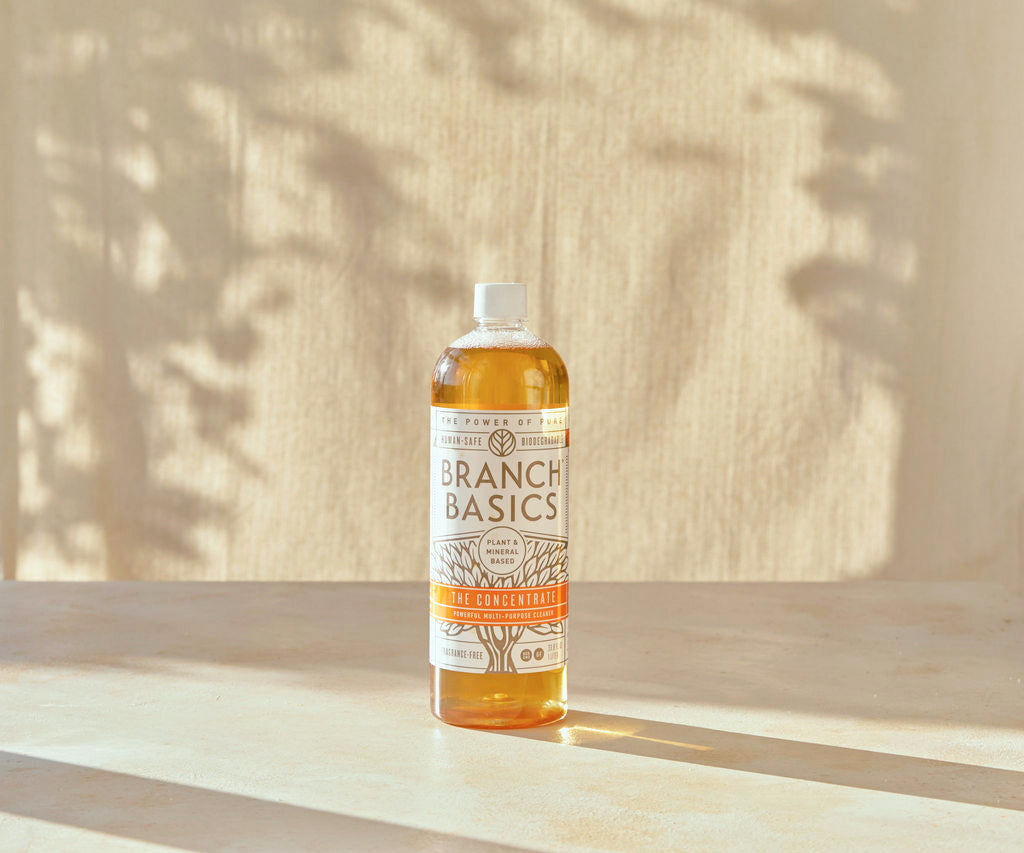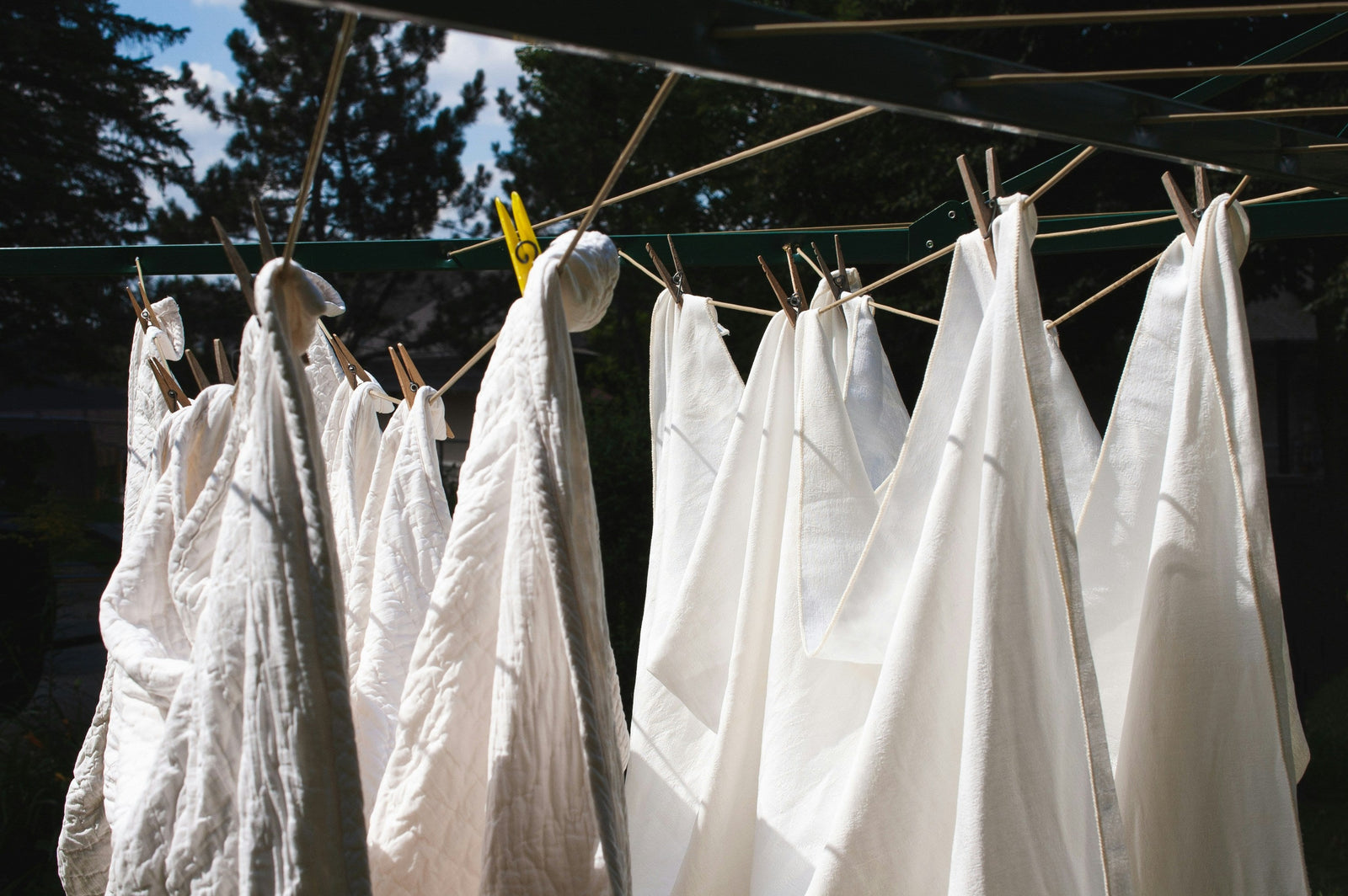Why Phosphate-Free Cleaning, Dishwashing, and Laundry Products Matter

Most health-conscious consumers have come across the term “phosphate-free” when researching healthy cleaning and laundry products.
But what exactly are phosphates, and why should they be avoided?
In this article, you’ll get the scoop on phosphates, including what they are, why they’re used in cleaning and laundry products, why they’re considered toxic, how to spot them on labels (they’re not always obvious), and what to use instead.
Phosphates In Cleaning Products
Phosphates are a group of chemical compounds containing phosphorus, a naturally occurring element.
Phosphorus is an essential mineral found in the earth and the human body and is not harmful in its natural state.
However, it becomes problematic for humans, wildlife, and the environment when it’s used to create synthetic phosphate-based chemicals. This is why many countries and states have strict regulations or bans on phosphate use.
The most common phosphate chemical used in cleaning and laundry products is sodium tripolyphosphate or STPP, which is used in various detergents as a surfactant.
STPP serves many functions in synthetic cleaning and laundry products, including:
- Removing stains
- Degreasing
- Increasing foaming
- Increasing shine
- Reducing the surface tension of water (surfactant qualities)
- Reducing mineral deposits in dishwashing by helping the detergent coat the surface of dishes
- Acting as an emulsifier
- Acting as a water softener
It’s also used in food production to make foods, such as seafood, appear more glossy and increase their sale weight (yikes!), in processed foods and beverages as an additive, in fertilizers, and certain drugs, like laxatives and enemas.
A growing awareness about phosphates' environmental impacts has caused many cleaning companies to offer phosphate-free alternatives.
However, due to their effectiveness and cheap cost, phosphates are still widely used in many synthetic detergents (dish and laundry) and cleaning products.
Related read: 5 Best Laundry Detergents Without Chemicals
Dangers Of Phosphates In Cleaning Products, Laundry And Dish Detergents
As previously mentioned, synthetic phosphates threaten human, wildlife, and environmental health, making them a wise ingredient to avoid.
Many countries have banned the use of phosphates, and several states within the United States have regulations on the use of high-phosphate dish detergents.
Let’s break this down by category.
The Human Health Impacts Of Phosphates
Synthetic phosphates, especially if consumed in excess, have the potential to negatively impact several aspects of human health, including: [Sources 1, 2, 3, 4]
- Kidney function
- Bone function
- Cardiovascular function
- Cell function
- Endocrine function
- Thyroid function
- Phosphate toxicity has also been associated with premature aging
Phosphate exposure has also been linked to:
- Skin irritation
- Respiratory irritation
- Asthma
How are phosphates consumed?
As previously noted, phosphate metabolites are used in processed foods, beverages, and other foods, like seafood.
Water treatment plants are also largely ineffective at removing phosphates from drinking water hence tap water can also be a source.
Then, there is the amount of phosphates our skin absorbs from contact with phosphate-containing cleaning and laundry products such as dish soap, laundry detergent, and other common cleaners.
Sure, a little phosphate consumption or exposure is likely no big deal.
However, the potential cumulative effects of phosphates in our immediate environments creates cause for concern.
The environmental impacts of phosphates, which we’ll cover next, can also have toxic effects on humans.
Fortunately, there is so much you can do to reduce your exposure to phosphates, which we’ll discuss coming up!
The Wildlife And Environmental Impacts Of Phosphates
The primary environmental concern about phosphates is that when they are washed down the drain (which happens every day in homes and businesses across the globe that use detergents), they cause water pollution.
Specifically, phosphate-containing detergents starve aquatic environments of oxygen, creating algal blooms that kill and/or sicken fish, shellfish, and all aquatic life.
This also affects land-dwelling creatures, such as eagles, bears, otters, etc., who rely on fish, seafood, and other aquatic life to survive.
People can also be harmed by the toxins created by certain types of algal blooms, which also create economic hardships for coastal or other lake/riverside communities that rely on clean water for their livelihoods.
It never fails. What hurts our environment also hurts us…and vice versa.
How To Find Hidden Phosphates On Labels
Reading cleaning and laundry product labels can get tricky, especially if a company doesn’t disclose all its ingredients.
This is why we recommend looking for products labeled “phosphate-free” and using consumer advocate tools like EWG’s Skin Deep and Guide to Healthy Cleaning databases to vet your cleaning and laundry products.
Fortunately, phosphate use has been reduced over the past several decades.
That said, they are still commonly used, especially in dishwashing and laundry detergents.
Here are some common names for phosphates to watch out for:
- Sodium tripolyphosphate (this is the most common form of phosphates used in cleaning products)
- Sodium phosphate (primarily found in air fresheners)
- Disodium phosphate
- Tetrasodium phosphate (primarily found in dishwashing detergent and rinse aids)
- Phosphoric acid, Trisodium Salt, Dodecahydrate (all-purpose cleaners and disinfectant wipes)
The National Environmental Education Foundation (NEEF) has a list of states that have banned or regulated phosphates in detergents.
Phosphates are more challenging to identify in foods because they are not always disclosed.
If you see “phosphorus” on the nutritional label of a food product made with truly all-natural ingredients, then there’s no cause for concern.
However, ingredients like “phosphorus” or “phosphoric acid” (found in soda) in processed foods or beverages are a dead giveaway.
What To Use Instead Of Phosphate Cleaning, Dishwashing And Laundry Products
The easiest way to avoid phosphates in cleaning products and detergents is to look for “phosphate-free” products.
However, “phosphate-free,” though a step in the right direction, does not indicate a product is human-safe or free from harmful chemicals.
All too often, cleaning companies greenwash toxic products by using phrases like “phosphate-free,” “fragrance-free,” or “sustainable” to puff up their synthetic products.
Instead, look for brands that are truly human-safe and free from phosphates and other harmful chemicals.
Certifications like “Made Safe” and “EWG-Verified” are good ones to look for, as are low toxicity ratings on EWG’s Skin Deep. databases, which will rate products and ingredients on a scale from 1 (least toxic) to 10 (most toxic).
We recommend only choosing products with all ingredients rated “1” or “2” on EWG Skin Deep , like Branch Basics.
Our products, including Branch Basics Concentrate, Oxygen Boost, Dishwasher Tablets, and Gel Hand Soap are EWG-verified, Made Safe Certified, phosphate-free, free from fragrance and fragrance-masking chemicals, never tested on animals, biodegradable, and non-GMO.
Learn more about our formulas and how our signature Concentrate can replace every cleaning and laundry product in your home in: How To Get Started With Your Branch Basics Kit.
*We use only naturally-derived, phosphate-free surfactants from non-GMO corn or coconuts.
Toss The Toxins With Branch Basics
We hope this article has empowered you to make safer choices about phosphate-free cleaning, laundry, and dishwashing products.
For more information about Branch Basics products, check out our Starter Kits and Dishwasher Tablets.
For more tips on tossing the toxins to create a healthier home, check out our Toss The Toxins Online Course and the following articles:








